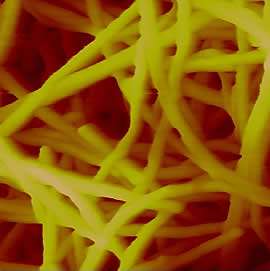New Properties Discovered for Nanotube Sheets

A team of nanotechnologists at The University of Texas at Dallas, along with Brazilian collaborators, have discovered that sheets of carbon nanotubes can produce bizarre mechanical properties when stretched or uniformly compressed. These unexpected but highly useful properties could be used for such applications as making composites, artificial muscles, gaskets or sensors. The team’s findings are reported in the April 25 issue of the journal Science.
When most materials are pulled in one direction, they get thinner in the other direction, similar to how a rubber band behaves when it is stretched. However, specially designed carbon nanotube sheets, dubbed “buckypaper,” can increase in width when stretched. The buckypaper can also increase in both length and width when uniformly compressed.
Ordinary materials contract laterally when stretched — a phenomenon that can be quantified by Poisson’s ratio, which is the ratio of the percent lateral contraction to the percent applied stretch.
Without realizing it, people have been using Poisson’s ratio for more than 2,000 years — in the form of wine bottle corks. Corks have a near-zero but positive Poisson’s ratio, which makes them difficult to insert but easy to remove. The opposite would be true if the cork had a negative Poisson’s ratio.
Dr. Ray H. Baughman, Robert A. Welch Professor of Chemistry and director of UT Dallas’ NanoTech Institute, and his colleagues created their nanotube sheets, or buckypaper, by using ancient methods for making ordinary writing paper — by drying a fiber slurry (Figure 1). The slurry has a mixture of carbon single-walled nanotubes (SWNTs) and multi-walled nanotubes (MWNTs). The researchers found that increasing the amount of MWNTs in the paper produced a sharp transition from a positive Poisson’s ratio of about 0.06 to a much larger magnitude negative value of about -0.20.
As described by the team in Science, this transition can be understood by relating the deformation modes of the nanotube sheets to those of a collapsible wine rack (see Figure 2). If two neighboring nanotube layers are coupled like the struts in a compressible wine rack, Poisson’s ratio is positive and the rack becomes narrower when stretched. In contrast, if the rack is blocked so that it can no longer be collapsed but the struts are stretchable, increases in strut length produce a negative Poisson’s ratio.
“This abrupt switching of the sign of Poisson’s ratio is so surprising and the structure of the nanotube sheets is so complicated that we initially believed that quantitative explanation was impossible using state-of-art theoretical capabilities,” said Baughman, the article’s corresponding author. “Distant daily teaming with our Brazilian colleagues through the Internet enabled us to jointly extract essential features from a structure that was much too complex for complete analysis, leading to our successful wine-rack-like model.”
Baughman and his team subsequently found that the nanotube sheets containing both single-walled and multi-walled nanotubes had a 1.6 times higher strength-to-weight ratio, 1.4 times higher modulus-to-weight ratio and a 2.4 times higher toughness than sheets made of SWNTs or MWNTs alone.
According to Baughman, the implications of the discovery that properties can be enhanced by mixing nanotube types can likely be extended from nanotube sheets to other nanotube arrays, like the twisted nanotube yarns Baughman and colleagues invented in 2005.
Similarly, the ability to tune Poisson’s ratio (Figure 3) could be exploited for designing sheet-derived composites, artificial muscles, gaskets, stress and strain sensors and chemical sensors.
A thick nanotube sheet could also be made to wrap around a concave, convex, or saddle shaped surface depending on the sign of Poisson’s ratio — something that could come in useful for forming shaped composites.
By choosing the ratio of SWNTs and MWNTs, the Poisson ratio can be adjusted to zero, which is useful for designing cantilevers for sensing that do not distort in width during bending. Tensile sensors can provide a sensitivity that is proportional to the volume change produced by stretch, and this volume change can be increased by the team’s discovery of the tunability of Poisson’s ratio.
The breakthroughs resulted from the diverse expertise of the article’s co-authors, who come from around the world: Dr. Lee Hall and Dr. Ray Baughman from the U.S., Dr. Vitor Coluci, Dr. Douglas Galvão, and Dr. Sócrates Dantas from Brazil, Dr. Mikhail Kozlov from the Ukraine and Dr. Mei Zhang from China. Hall, the first author on the article, made his contributions to the discovery as part of his Ph.D. under the direction of Baughman. Lee and Baughman previously co-authored a paper in Science about fuel-powered artificial muscles.
Source: University of Texas at Dallas





















